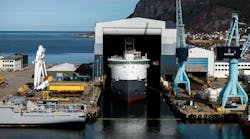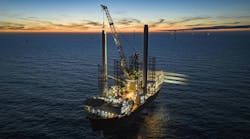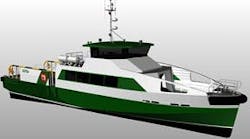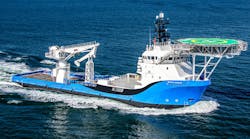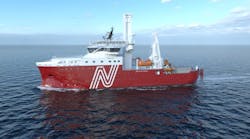An analysis of offshore projects under development or study in West Africa and South America shows evolution from tra di tional water depths to ultra-deep water (3,000 meters). On this basis, Bouygues Offshore and Saipem are building a vessel adapted to meet these ultra-deepwater needs.
Saibos Construçoes Maritimas Lda. (Saibos CML), the two companies common subsidiary (50/50) dedicated to offshore installation and contracts in the South Atlantic, will be the owner and operator, and is managing construction of the vessel.
Preliminary conceptual studies and basic engineering were undertaken in 1997. The engineering subcontract was placed with Shiffko Gmbh. of Hamburg, Germany in March 1998, as soon as the final agreement between Bouygues Offshore and Saipem and an accurate evaluation of the investment have been frozen. The total investment is US$150 million. All main equipment orders were issued at the end of 1998, along with the shipyard order. The vessel will be available in September 2000.
Vessel maneuvering
The FDS is a multipurpose crane and pipelaying dynamically positioned (DP) construction vessel. The three main criteria for the vessel are:
- Develop offshore oil and gas fields in water depths up to 3,000 meters
- Lift and transport heavy subsea and surface modules and equipment.
- Transit between construction sites at a cruising speed of 14 knots.
The FDS is being built according to codes Solas/ILO/Marpol with a DNV classification +1A1 (EO-Dynpos-Autro-DSV II/III SF-HLDK-SH-ICE C) and is compliant with Norwegian, UK, and USCG regulations for foreign flag vessels.
The vessel has been designed for sea conditions in the South Atlantic. Tests carried out confirm the optimum behavior of the vessel. The nat ural period of the ship is 15 seconds in pipelaying mode, which is above the swell periods encountered in the areas where the vessel will be working.
The J-lay operation roll has single maximum amplitude of 5° and the main crane operation angle is 2°. Assurance of stability in operation is made possible with the following systems:
- Anti-rolling with two span bilge keels of 1.24 meters
- Ballast system installed with two 300 cu meters/hr electric pumps
- Crane compensation by utilizing eight 1,500 cu meter/hr electric pumps.
- Total sea water ballast capacity is 11,539 cu meters including the two 1,276 cu meter tanks (one on each side) for the crane ballast itself.
Dimensions
The vessel is 157.5 meters long and 30 meters wide and has an operating displacement of 25,300 tons with a payload capacity of 4,300 tons. The operating draft is 7.4 meters with a free board of 5 meters. Total installed power of 25 MW is produced by diesel-driven generators, with 6.6 KV distributed to all user motors, including six thrusters configured as follows:
- Two stern thrusters for DP and sailing
- Two fore thrusters (azimuth and retractable) for DP
- Two bow thrusters in tunnels for DP.
The vessel is designed to accommodate an optional thruster in order to increase the operational Bollard pull from 50 metric tons to 80 metric tons, if it appears to become necessary in the future. For this type of vessel, the stationkeeping capability must be efficient in order to limit the number of weather stoppages during operations. A particular care and best of art equipment has been chosen based on proven technology. The DP capacities are:
- In pipelaying mode, DYNPOS AUTR, DNV DP II, with 50 tons Bollard pull at sea state 5 and a current of 1.5 knots, all acting abeam
- In subsea mode, DYNPOS AUTRO, DNV III, without Bollard pull and with the same other conditions.
The various capacities are such that the vessel has an autonomy well above 30 days. This characteristic is important considering the sites of operation and the opportunities to work on both sides of the Atlantic Ocean. The cruising speed of 14 knots allows the vessel to move rapidly from one site to another.
Efficient line
The J-lay tower and firing line have been designed to achieve high productivity. Quad-joint strings (52 meters length maximum) are prepared on deck using the permanent firing line. The strings are installed through the J-lay tower in friction or collar mode, with a hang-off clamp at the bottom and a traveling clamp to allow the transit of the string in the tower.
The tower is designed for 400 metric tons tension with a tilting angle of 45° to 96°. Calcu lations show that such tension allows the laying of pipes in the range of diameters usually used for the flowlines or water injection lines up to water depths of 2,000-3,000 meters. The tower itself is designed for pipe string up to 20 in. outside diameter.
The firing line is organized on the deck to assemble the quad-joints strings in five working stations for welding, NDT, coating. The space on deck (3,000 sq meters) is available for storage of standard pipe joints (12 meters) or onshore-prepared quad-joints for pipe-in-pipe flowlines or special steel. Large capacity and heavy racks are loaded without any external help thanks to the vessel main crane capacity.
Installation of flexible pipes (up to 15 in. internal diameter) is executed through the J-lay tower or an overboarding chute with the use of four 90-metric-ton tensioner (maximum of three) pads. The large deck area allows the utilization of several vertical turrets (10 or 15, depending upon deck configuration). Space is available for the installation of a 1,600 metric ton carousel below the deck.
Parallel installation
The combined installation in parallel of pipes, flexibles, and umbilicals is one of the characteristics of the vessel. The design of the vessel enables the installation of every type of pipe, flexible, and umbilical commonly used in deep water. The number of vessels on site is therefore limited to the FDS itself. Keeping this in mind, and in order to work in autonomous mode, the lifting capability of the FDS's cranes was designed accordingly:
- One main crane of 600 metric tons at 30 meters, and 300 metric tons at 55 meters
- Two 30-metric-ton auxiliary cranes
- Two 20-metric-ton auxiliary cranes.
This allows lifting of pipes and pipe racks onboard, module installation on floating pro duction, storage, and offloading units (FPSO) or other floating units (Spar, TLP), temporary decks or module support frames, as well as installation of mooring systems.
The lifting and handling capabilities are increased by the utilization of the abandonment and recovery (A&R) winches (400 metric tons for 3,000 meters water depth, or 600 metric tons for 1,500 meters water depth). An auxiliary winch (100 metric tons) can be used for portside transfer of modules from deck to sea.
Working in deepwater also requires subsea equipment. Two work class ROVs, rated for 3,000 meters water depth, will be on board permanently. These 150 hp ROVs have extended TMS capacities and an 800-meter horizontal excursion range. These capabilities will allow the monitoring of the touchdown point directly from the vessel, avoiding the use of a specific vessel for such operations. A large range of subsea tools for utilization by the ROVs will be available.
A large range of activities will be executed by the FDS vessel. For example:
- Diversified pipelaying, using rigid pipes (insulated or not), flexible pipes, umbilicals, and others
- Extended lifting and handling capabilities
- Storage capability on deck for pipes, flexibles, moorings, and modules.
- Subsea installation and operations.
The FDS is a versatile, multipurpose vessel adapted to areas in the South Atlantic. As operator, Saibos CML intends to be a major player for coming ultra-deepwater field developments.



